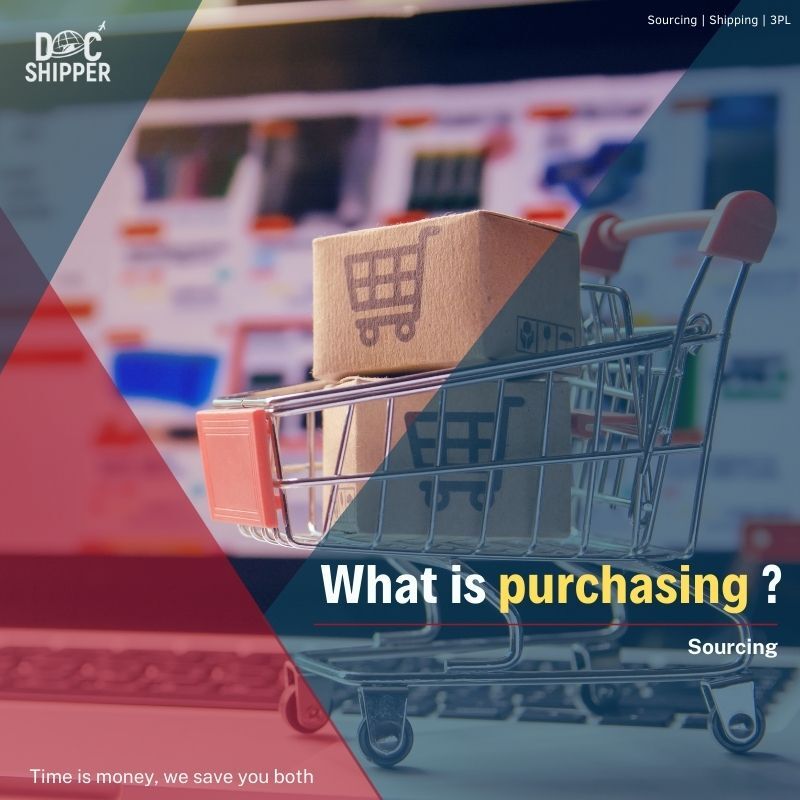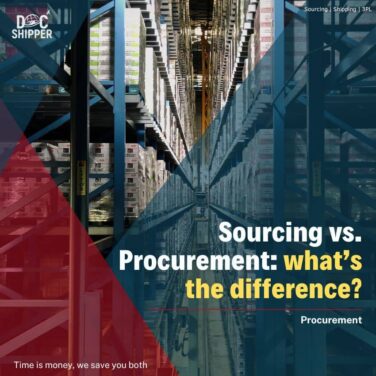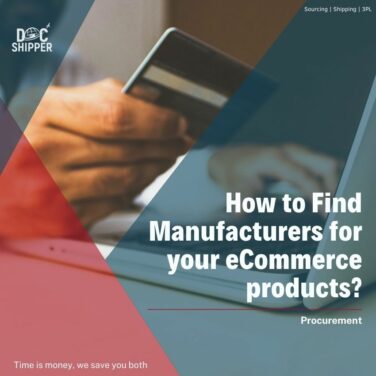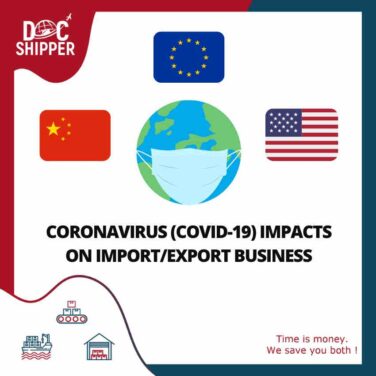In the ever-evolving landscape of modern business, success hinges on effective resource management. Two terms, Procurement and Purchasing, are vital but often confused components of organizational strategy. This guide aims to clarify their distinctions and unlock your organization’s potential.
We embark on a journey to demystify procurement and purchasing, using relatable analogies and real-world examples. Our mission is to equip you with the knowledge needed to differentiate between these concepts and take action to enhance your organization’s practices.
Explore the pivotal role played by purchasing consultants and managers in architecting streamlined, efficient processes. Join us on this enlightening exploration, where clarity illuminates the path to optimization, and simplicity is the cornerstone of success.
What is Purchasing?

Purchasing, in the intricate tapestry of supply chain management, emerges as a cornerstone process. It encompasses the systematic and organized acquisition of goods and services on behalf of an organization. At its core, purchasing is designed to meet the immediate needs of a company, ensuring a timely and cost-effective procurement of essential items. In essence, purchasing is the engine that drives the procurement process. It’s responsible for securing the vital components that keep a company’s operations running smoothly. However, it’s crucial to recognize that purchasing is just one vital piece of the larger supply chain puzzle.
Procurement, a comprehensive process that extends beyond the boundaries of purchasing, focuses on the strategic acquisition of supplies. Its goal is to secure these supplies in alignment with demand while optimizing costs. The realm of procurement encompasses multifaceted aspects, including expediting, ensuring supplier quality, managing logistics, and, undoubtedly, purchasing.
Purchasing and procurement function in tandem, their synergy forming the bedrock of a robust supply chain. While purchasing attends to immediate needs, procurement takes a long-term view, striving for cost efficiency and supply chain resilience. This harmonious partnership ensures that an organization not only thrives in the present but also remains well-prepared for future challenges and opportunities.
Now that we’ve unraveled the essence of purchasing within the broader landscape of procurement and supply chain management, let’s continue our journey to differentiate between procurement and purchasing.
Procurement vs. Purchasing: What makes them distinct?
In the realm of supply chain management, the terms Procurement and Purchasing are often used interchangeably, leading to confusion. However, they are distinct processes, each serving a unique purpose within an organization. Let’s shed light on the differences and similarities between them in a comparative view:
| Aspect | Purchasing | Procurement |
| Definition | Acquisition of goods and services to meet immediate needs. | A strategic process involving sourcing, negotiation, and selection of goods and services for long-term organizational goals. |
| Focus | Short-term, meeting current needs. | Long-term, aligning with organizational strategy. |
| Scope | Narrow in scope, transactional. | Broader in scope, encompassing strategy. |
| Vendor Selection | Often involves selecting from established suppliers. | Involves identifying, vetting, and selecting suppliers strategically. |
| Process Complexity | Relatively straightforward. | Involves multiple stages and greater complexity. |
| Timeframe | Typically immediate. | Deliberate and may take longer. |
| Strategic Importance | Tactical importance for daily operations. | Integral to corporate strategy and organizational performance. |
| Process Involvement | Primarily carried out by purchasing departments. | Involves multiple stakeholders across the organization. |
| Key Considerations | Cost-effectiveness and timely procurement. | Supplier relationships, cost optimization, and long-term supply chain efficiency. |
While purchasing is a crucial part of the procurement process, it’s important to recognize that procurement extends beyond immediate transactions. It encompasses strategic planning, supplier relationship management, and long-term cost optimization, making it a pivotal driver of an organization’s overall performance.
As we delve deeper into our exploration, we’ll further dissect the roles and significance of both procurement and purchasing in the context of supply chain management.
DocShipper Alert
DocShipper Alert: Optimize your purchases with our expert assistance, saving you time and money on all your China procurement needs. Fill out the form and contact us or give us a call via WhatsApp inorder to simplify your procurement process with our expert guidance.
Let’s discover Purchasing Cost and its Significance
In the world of procurement and purchasing, understanding the concept of purchasing cost is paramount. This section delves into the intricacies of purchasing cost and its far-reaching implications on an organization’s overall business expenses.
Purchasing cost refers to the total expenditure incurred by a business or organization in acquiring goods and services. It encompasses not only the actual cost of the items purchased but also various associated expenses. To gain a comprehensive understanding, consider the following components:
- Direct Costs: These are the upfront expenses directly associated with the purchase of goods or services. They include the negotiated price, shipping costs, taxes, and any additional fees.
- Indirect Costs: Often overlooked, these costs are not immediately tied to the purchase but can have a significant impact. Examples include storage costs, handling costs, and quality control expenses.
- Opportunity Costs: These represent the potential benefits or profits an organization forgoes by choosing one supplier or product over another. Opportunity costs can be substantial when making strategic procurement decisions.
Why is understanding and managing purchasing costs so crucial?
Here are some key reasons:

Cost Efficiency
Effective cost management ensures that a business obtains goods and services at the most favorable terms, minimizing financial waste.

Profit Margins
Controlling purchasing costs directly influences a company’s profit margins. Lower costs mean higher profits, which can be reinvested or allocated for growth.

Competitiveness
Businesses that can offer competitive prices to their customers often gain a competitive edge in the market, leading to increased sales and market share.
 Resource Allocation
Resource Allocation
Efficient purchasing cost management frees up resources that can be allocated to other critical areas, such as innovation or expansion.
 Supplier Relationships
Supplier Relationships
Maintaining a strong and collaborative relationship with suppliers can lead to favorable pricing and terms, reducing overall purchasing costs.
Understanding the significance of purchasing costs involves examining their impact on overall business expenses.
Understanding the significance of purchasing costs involves examining their impact on overall business expenses. Consider the following scenarios:
Scenario 1: An organization secures a long-term contract with a supplier that offers lower unit prices. This strategic move reduces direct purchasing costs, positively affecting the bottom line.
Scenario 2: Inefficient inventory management leads to high storage and handling costs. These indirect costs eat into the savings gained from competitive purchasing, affecting overall profitability.
As we’ve explored the intricate landscape of purchasing costs and their impact on businesses, it’s clear that effective cost management is essential. Now, let’s delve into the practical side of things by looking at how purchasing costs are calculated with a real-world example.
How to Calculate the Cost of the Purchased Goods?
In this example, let’s say there were 100 items purchased at an average price of $10 each, resulting in a total purchase price of $1,000.
Identify any returns or allowances that occurred with the purchase. For instance, if 5 items were found to be defective and returned, this would result in a total return of $50.
Determine if there were any purchase discounts applied. In this scenario, a discount of $1 per item was granted, leading to a total discount of $100.
Calculate the cost of inbound freight if it was paid by the purchaser. For instance, if the inbound freight cost was $200, add this to the equation.
Now, you can calculate the cost of goods purchased using the formula:
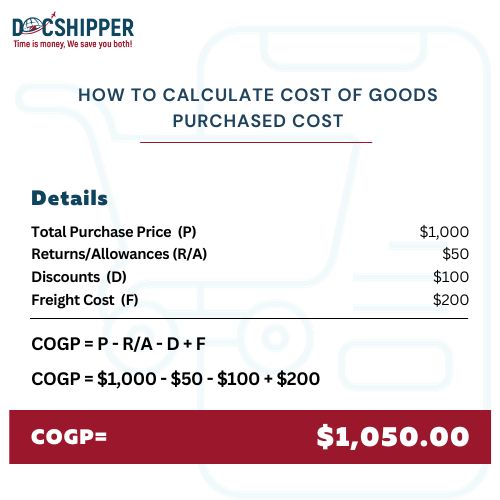 Stay with us as we uncover more insights into the dynamic landscape of procurement and purchasing.
Stay with us as we uncover more insights into the dynamic landscape of procurement and purchasing.
Why are Purchasing Consultants important?
In the intricate realm of procurement and purchasing, the role of a purchasing consultant stands as a beacon of expertise and guidance. This section illuminates the significance of purchasing consultants, defining their pivotal role in assisting businesses with procurement strategies.
What is The Role of a Purchasing Consultant?
A purchasing consultant is a seasoned professional who specializes in navigating the labyrinthine landscape of procurement. Their primary objective is to optimize a company’s procurement strategies, ensuring the most efficient and cost-effective acquisition of goods and services. To shed light on their role, consider the following aspects:
Strategic Sourcing

Purchasing consultants excel in identifying and selecting suppliers who align with a company’s strategic goals. They employ their extensive market knowledge to ensure that businesses collaborate with suppliers that offer quality, reliability, and competitive pricing. This is what we call: strategic sourcing.
Procurement Process Improvement

These consultants delve deep into a company’s procurement processes, analyzing each step for efficiency and effectiveness. By streamlining procedures, they eliminate bottlenecks and enhance the overall procurement workflow.
Negotiation and Contract Management

A crucial facet of their role involves negotiating contracts with suppliers to secure favorable terms and pricing. They also excel in contract management, ensuring that all parties adhere to the agreed-upon terms throughout the procurement relationship.
Cost Reduction Strategies

Purchasing consultants are adept at identifying opportunities for cost reduction without compromising the quality of goods or services. They seek out cost-saving measures, such as bulk purchasing, supplier consolidation, and value engineering.
How do purchasing consultants Add Value to the Procurement Process?
The true essence of a purchasing consultant’s importance lies in the value they bring to the procurement process. Here are examples of how these consultants can profoundly impact an organization:
- Cost Savings: Through their expertise in negotiation and cost reduction strategies, purchasing consultants help businesses achieve significant cost savings in procurement, thereby directly boosting profitability.
- Supplier Diversification: Consultants can broaden a company’s supplier base, reducing dependence on a single source and mitigating supply chain risks. This diversification enhances resilience and adaptability in procurement.
- Market Insights: Staying informed about market trends and dynamics is a core competence of purchasing consultants. They provide valuable insights, enabling businesses to make informed decisions and stay competitive.
- Risk Mitigation: By meticulously assessing and managing risks associated with suppliers, purchasing consultants safeguard a company’s interests. They establish contingency plans and mitigate potential disruptions in the supply chain.
- Enhanced Efficiency: The streamlining of procurement processes leads to enhanced efficiency. This means quicker procurement cycles, reduced administrative burden, and improved resource allocation.
DocShipper Info
DocShipper Info: Explore our simplified purchasing services that align with your organization’s goals, backed by expert assistance. Fill out the form and contact us or give us a Free call via WhatsApp to start simplifying your procurement process. Don’t miss this opportunity to enhance your procurement efficiency.
Let’s explore the 12 Key Steps in the Purchasing Process
The purchasing process unfolds through several fundamental stages, each contributing to the efficient acquisition of goods and services. These stages are vital for achieving successful procurement outcomes. Let’s delve into them:
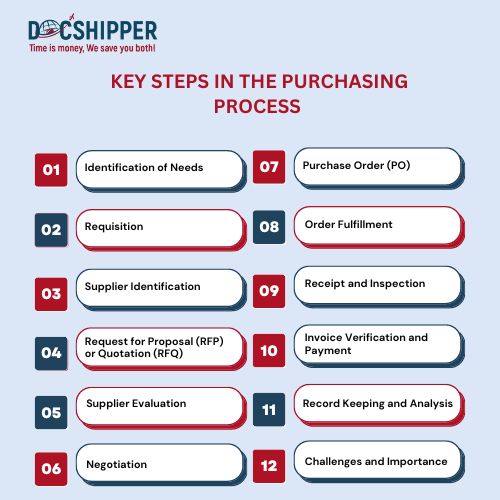
1. Identification of Needs
The process commences with the identification of an organization’s needs. This stage involves defining precisely what goods or services are required and in what quantity. Clear communication between departments and stakeholders is crucial to avoid discrepancies.
2. Requisition
Once needs are identified, a requisition is created, outlining the specifics of the required items. This document serves as an internal request and forms the basis for the subsequent purchasing process.
3. Supplier Identification
At this juncture, potential suppliers are identified and evaluated. This stage is pivotal in determining which suppliers can best meet the organization’s needs in terms of quality, pricing, and reliability.
4. Request for Proposal (RFP) or Quotation (RFQ)
In procurement, a Request for Proposal (RFP) is a formal document used by organizations when they have complex requirements or seek customized solutions. It provides suppliers with a comprehensive overview of the organization’s needs, goals, and expectations. In contrast, a Request for Quotation (RFQ) is typically employed when organizations have well-defined requirements and are primarily focused on obtaining competitive pricing for standardized products or services.
| Criterion | Request for Quotation (RFQ) | Request for Proposal (RFP) |
|
Structure |
More concise, focused on the price of a specific product or service. | More detailed, including information about the company, objectives, budget, etc. |
|
Purpose |
Obtaining the price for a specific product or service. | Obtaining detailed proposals for complex needs. |
|
Questions |
Mainly centered around price and payment terms. | Includes detailed questions about the company, skills, methodologies, etc. |
|
Process |
Drafting, sending to suppliers, receiving responses, price evaluation. | Identifying needs, supplier research, drafting, sending, receiving, detailed evaluation |
5. Supplier Evaluation
Supplier proposals are rigorously evaluated, considering factors like pricing, quality, delivery timelines, and compliance with requirements. This evaluation aids in shortlisting suppliers for further consideration.
6. Negotiation
Negotiations with shortlisted suppliers take place to reach mutually beneficial agreements. These negotiations encompass pricing, terms, delivery schedules, and other relevant aspects.
7. Purchase Order (PO)
After successful negotiations, a purchase order is issued to the chosen supplier. The PO outlines the specifics of the order, including quantity, pricing, delivery dates, and terms and conditions.
8. Order Fulfillment
Suppliers commence the process of fulfilling the order as per the agreed-upon terms. This stage involves manufacturing, packaging, and shipping of goods or providing the specified services.
9. Receipt and Inspection
Upon receiving the goods or services, the organization inspects them to ensure they meet the agreed-upon standards and specifications. Any discrepancies or defects are addressed at this stage.
10. Invoice Verification and Payment
Invoices from suppliers are verified for accuracy against the PO and other terms. Once validated, payment is processed promptly to maintain positive supplier relationships.
11. Record Keeping and Analysis
Comprehensive record-keeping of all procurement activities is vital for compliance and analysis. This data provides insights into spending patterns and supplier performance, enabling informed decisions.
12. Challenges and Importance
Each stage of the purchasing process presents unique challenges. Identifying needs accurately, selecting reliable suppliers, and ensuring compliance is crucial for successful procurement. Challenges may include supplier disputes, quality issues, and supply chain disruptions.
Navigating these stages efficiently is essential for organizations seeking to optimize their procurement strategies, minimize costs, and enhance overall efficiency.
Sourcing Strategies in International Purchasing
In the global marketplace, international purchasing requires strategic sourcing strategies to navigate complexities. One such strategy is the « Multiple Sourcing Purchasing Strategy, » while another is the « Simple Sourcing Purchasing Strategy. »
Simple Sourcing Purchasing Strategy
The Simple Sourcing Strategy is characterized by the practice of procuring goods or services from a single supplier or source. Unlike the Multiple Sourcing Strategy, which involves multiple suppliers, the Simple Sourcing Strategy concentrates on a single-source procurement model. This strategy offers several advantages, including:
- Simplicity and Ease of Management: By placing orders with a single supplier, supply chain management becomes simpler. There’s only one relationship to manage, reducing operational complexity.
- Reduction in Management Costs: Managing multiple suppliers can lead to higher administrative costs. With a single source, management costs are typically lower.
- Better Negotiation: Maintaining a long-term relationship with a single supplier often makes it easier to negotiate favorable terms, reduced prices, or advantageous payment terms.
- Development of Stronger Relationships: Working exclusively with one supplier can lead to stronger and deeper relationships. This can foster collaboration and innovation.
Multiple Sourcing Purchasing Strategy
The Multiple Sourcing Purchasing Strategy involves procuring goods or services from multiple suppliers rather than relying on a single source. This strategy offers several advantages, including:
- Risk Mitigation: Diversifying suppliers reduces dependency on a single source, mitigating the impact of supply chain disruptions, price fluctuations, or supplier-related issues.
- Enhanced Competition: Multiple suppliers encourage healthy competition, motivating suppliers to offer competitive prices and improved service quality.
- Quality Assurance: Organizations can compare the quality of products or services from different suppliers, ensuring adherence to quality standards.
- Flexibility: A multi-sourcing approach provides flexibility in adjusting procurement quantities or switching suppliers as per changing needs.
However, managing multiple suppliers for the « Multiple Sourcing Purchasing Strategy » and « Simple Sourcing Purchasing Strategy » also requires effective supplier relationship management and coordination to optimize the benefits of these strategies.
Real-World Purchasing Examples
Now, let’s explore real-world examples of successful procurement initiatives across various industries. These case studies highlight the tangible benefits and valuable lessons learned from these procurement endeavors.
Amazon’s Aggressive Supplier Negotiations
 Amazon, a global e-commerce giant, has adeptly employed procurement to streamline its supply chain. A notable instance is Amazon’s assertive approach to supplier negotiations, enabling the company to secure advantageous terms and lower prices from suppliers. This strategy played a pivotal role in Amazon’s expansion into new markets, where it strategically leveraged procurement to reduce the cost of goods.
Amazon, a global e-commerce giant, has adeptly employed procurement to streamline its supply chain. A notable instance is Amazon’s assertive approach to supplier negotiations, enabling the company to secure advantageous terms and lower prices from suppliers. This strategy played a pivotal role in Amazon’s expansion into new markets, where it strategically leveraged procurement to reduce the cost of goods.
Walmart’s Just-in-Time Inventory System
 Walmart, one of the world’s largest retailers, embodies efficiency and responsiveness in procurement. A key element of their success lies in their use of a just-in-time inventory system, ensuring that goods are produced and stocked precisely when needed. This minimizes waste and ensures that Walmart stores consistently offer the products that customers desire.
Walmart, one of the world’s largest retailers, embodies efficiency and responsiveness in procurement. A key element of their success lies in their use of a just-in-time inventory system, ensuring that goods are produced and stocked precisely when needed. This minimizes waste and ensures that Walmart stores consistently offer the products that customers desire.
Apple’s Supplier Relationships and Cost Optimization
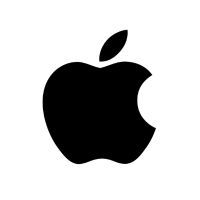
Apple, a leader in the tech industry, has implemented a procurement strategy founded on strong supplier relationships, flexibility, and cost reduction. They prioritize the establishment of robust, long-term relationships with suppliers, granting them access to new products and favorable terms. Additionally, Apple’s commitment to cost optimization includes a team of expert negotiators continuously working to secure lower prices.
Ethical Procurement Practices in Developing Countries
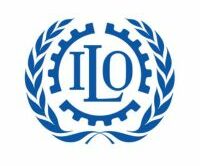 The International Labour Organization (ILO) provides a case study on the positive impact of ethical procurement practices on small and medium-sized enterprises (SMEs) in developing countries. This study highlights the significant benefits that result from ethical and strategic procurement practices.
The International Labour Organization (ILO) provides a case study on the positive impact of ethical procurement practices on small and medium-sized enterprises (SMEs) in developing countries. This study highlights the significant benefits that result from ethical and strategic procurement practices.
Public Procurement for Sustainable Development
 The Organization for Economic Co-operation and Development (OECD) underscores the role of strategic public procurement in advancing sustainable development goals. This report investigates how governments can harness procurement practices to promote sustainability, foster innovation, and achieve societal objectives.
The Organization for Economic Co-operation and Development (OECD) underscores the role of strategic public procurement in advancing sustainable development goals. This report investigates how governments can harness procurement practices to promote sustainability, foster innovation, and achieve societal objectives.
DocShipper Alert
DocShipper Alert: Transform your purchasing with our procurement experts. Our dedicated team is ready to assist you in achieving procurement success. Fill out the form to contact us or call us on WhatsApp at no charge to get started. We’re committed to your procurement success with our expert guidance.
Purchasing Management: Roles, Responsibilities, and Career Paths in Procurement
Purchasing management stands as a pivotal cornerstone of operational efficiency and profitability for any business. It encompasses acquiring the essential goods and services a company requires to function seamlessly. At its core, this discipline ensures that an organization acquires these necessities in the most cost-effective, timely, and quality-focused manner possible. The stewardship of this essential function falls to competent professionals known as purchasing managers, who play an integral role in the success of a company.
What is a Purchasing Manager responsible for?
A purchasing manager is someone who makes important decisions about what a company buys. They ensure that everything the company needs is purchased in the best way possible. This means they need to be savvy in getting good prices and making sure things arrive on time.
If you want to become a purchasing manager, there are certain steps you can take:
- Educational Foundation: Start by earning a college degree in business or management.
- Professional Experience: Gain practical experience in the field of purchasing through employment opportunities.
- Certification: Consider obtaining a certification in purchasing management to validate your expertise.
These steps will guide you on the path to becoming a qualified purchasing manager.
What are the Purchasing Manager’s main roles?
Purchasing Managers play a pivotal role within an organization, encompassing a wide array of responsibilities to ensure the efficient procurement of goods and services. These responsibilities include:
- Strategic Sourcing: Purchasing Managers act as diligent seekers, scouring the market for optimal suppliers and sources to secure the best possible deals for the company. This involves conducting thorough market research, evaluating potential vendors, and scrutinizing product quality and pricing.
- Negotiation Expertise: Negotiation isn’t just a skill; it’s an art. Purchasing Managers engage in negotiations with suppliers, using their expertise to secure favorable terms, including competitive prices, discounts, and beneficial contractual conditions.
- Supply Chain Mastery: They take on the role of supply chain maestros, overseeing the entire process from procurement to delivery. This entails nurturing relationships with suppliers, vigilantly monitoring inventory levels, and fine-tuning logistics for seamless operations.
- Cost Control: In the quest for financial prudence, Purchasing Managers keep a watchful eye on costs, perpetually seeking avenues to trim expenses without compromising product quality or punctual delivery.
- Quality Assurance: They bear the responsibility of ensuring that all procured goods and services meet the company’s exacting quality standards. This involves setting quality benchmarks, conducting meticulous inspections, and addressing any quality-related concerns.
- Risk Management: Purchasing Managers are the sentinels guarding against potential risks associated with suppliers, contracts, and the supply chain. They craft contingency plans to deftly navigate unforeseen challenges that might disrupt the procurement process.
- Compliance: Adherence to relevant laws, regulations, and industry standards is paramount. Purchasing Managers stay abreast of legal requirements and ensure that all procurement activities align meticulously with these standards.
How much does a Purchasing Manager own?
When it comes to salaries, Purchasing Managers can earn a substantial income, with figures that can vary based on factors such as experience, location, and the specific industry. In the United States, the average base salary for a Purchasing Manager in 2023 is approximately $82,324 per year as reported by Indeed. Salary ranges can vary, with the lower end starting at approximately $56,764 annually and the higher end reaching about $119,393 per year.
After this understanding, let’s proceed to discuss effective purchase order management strategies in the following section.
How to ensure effective purchase order management?
Purchase orders play a crucial role in the world of procurement. They serve as formal documents that communicate a company’s intent to purchase goods or services from a supplier. These documents include essential details such as the type and quantity of items, agreed-upon prices, delivery terms, and payment terms. The significance of purchase orders lies in their ability to streamline the procurement process, reduce errors, and ensure smooth transactions.
In this section, We will explore what a purchase order is, its key components, and its role in procurement.
What is a Purchase Order?
A purchase order is a legally binding document issued by a buyer to a seller. It serves as a clear record of the items or services a company intends to purchase and the terms of the transaction. Key components of a purchase order include the item descriptions, quantities, unit prices, payment terms, and delivery instructions. Purchase orders are essential in procurement because they help companies maintain accurate records, track expenses, and ensure that both parties in the transaction are on the same page. They provide a level of formality and structure to the purchasing process, reducing the potential for misunderstandings or disputes.
In the context of order management, a purchase order serves as the foundation for implementing effective strategies to streamline operations and enhance customer satisfaction.
4 Strategies for Effective Order Management
To ensure that your business operates smoothly and leaves customers satisfied, it’s imperative to manage orders effectively. Now, we will explore four strategies designed to enhance your order management process:
1. Automation with ERP Solutions
Implementing automation, especially through Enterprise Resource Planning (ERP) systems like Odoo, can significantly improve order management. Automation reduces the chances of errors and speeds up order processing. ERP systems offer tools for forecasting, customer relationship management, and order automation, leading to increased efficiency and higher revenue.
2. Serious Analytics and Communication
Utilize analytics tools provided by ERP systems to gain insights into your business decisions. Real-time tracking and evaluation of products and processes streamline operations. Communicate these insights with your team to keep everyone informed and prepared to make data-driven decisions.
3. Build Customer and Supplier Relationships
Enhance the customer experience by delivering personalized and memorable service. Engage with your customer base through social media platforms to gather feedback and improve your processes. Use customer relationship management features in your ERP system to track customer queries and needs. Additionally, maintain strong relationships with reliable suppliers, especially those compatible with your software, to ensure seamless order management.
4. Inventory Management and Flexible Delivery
Keep your inventory in check with real-time tracking through ERP system plugins. Maintain flexibility in your delivery methods to accommodate changing customer expectations. Consider factors like location, available shipping options, and cost-benefit analysis to provide efficient and adaptable delivery solutions.
These strategies can help businesses optimize their order management processes, reduce errors, and enhance customer satisfaction.
5 Purchase Order Management Best Practices
When it comes to managing purchase orders effectively, there are several best practices to consider. These practices can help streamline your procurement process, reduce errors, and improve overall efficiency. Here are some key best practices for purchase order management:
- Have a Clear Process: Establish a clear and repeatable process for creating and managing purchase orders. This process should be straightforward and reliable to ensure consistency in your procurement workflow.
- Receive Internal and External Confirmation: Communication is key in purchase order management. Ensure that both internal and external stakeholders confirm the details of each purchase order. This helps prevent misunderstandings and ensures everyone understands their roles and responsibilities.
- Ensure Quality at Delivery: The process of checking and confirming doesn’t end with the creation of the purchase order. It’s essential to evaluate the quality and condition of goods upon delivery. Note any exceptions and work with suppliers to address any issues promptly.
- Track and Report on Spending: In addition to focusing on timely delivery, it’s crucial to analyze your purchase data for future improvements. Using purchase order management as a reference point in your procurement lifecycle allows you to assess the effectiveness of your purchasing and identify areas for enhancement.
- Consider Using Technology: Technology, such as purchase order management software, can automate many aspects of the process. This includes tracking purchase orders, creating an audit trail, and simplifying reporting, resulting in more efficient operations.
With these best practices in mind, you can enhance your purchase order management process and drive better results.
Top 7 best purchase management software
Choosing the right purchase order management software is crucial for optimizing your procurement processes. Here, we’ve highlighted some of the best purchase order management software options available, each with its unique strengths and capabilities:
- ProcureDesk: Ideal for companies requiring robust catalog support and seamless integration with their accounting systems. ProcureDesk streamlines procurement and purchasing operations, making it an excellent choice for businesses with complex purchasing needs.
- Procurify: Tailored for medium-sized companies, Procurify offers a user-friendly interface and comprehensive features for efficient purchase order management. It simplifies procurement workflows, making it easier to track spending and control costs.
- Kissflow: If your company needs a flexible workflow engine to adapt to changing procurement requirements, Kissflow is an excellent option. It allows for customization and automation of purchase order processes to suit your unique needs.
- Tradogram: Specifically designed for construction and project-related spending, Tradogram offers tools for managing procurement in these industries. It helps streamline purchasing operations and enhances project cost control.
- Spendwise: For businesses seeking a cost-effective solution, Spendwise provides a budget-friendly option. It’s suitable for companies that need essential purchase order management capabilities without breaking the bank.
- Precoro: Companies with global operations will find Precoro to be a valuable asset. It offers international procurement support, making it easier to manage purchases across different regions and currencies.
- Order: If your company requires a marketplace solution integrated with purchase order management, Order is a top choice. It provides a comprehensive platform that combines purchasing, vendor management, and marketplace features.
Choosing the best purchase order management software depends on your specific business needs and objectives. Consider your industry, company size, and purchasing requirements when selecting the right software for your organization.
Future of Purchasing
The world of procurement is on the brink of a profound transformation. Emerging technologies and evolving trends are redefining how businesses manage their procurement processes. Automation, artificial intelligence (AI), and data analytics are poised to play pivotal roles in the procurement landscape. We will discuss the potential impact of these innovations on the future of procurement services.
Environmental and Ethical Considerations
As the global community becomes more conscious of environmental and ethical issues, businesses are recognizing the importance of sustainable and ethical procurement practices. In this subsection, we will highlight the growing significance of these principles in procurement and explore how organizations can incorporate them into their procurement strategies.
DocShipper Alert
DocShipper Info: Stand out from the competition with our procurement services, enhanced by expert assistance. Gain a competitive edge in procurement by partnering with us. Fill out the form and contact us now or just make a WhatsApp call for free to explore the possibilities with our expert guidance.
In the dynamic world of modern business, efficient procurement services are indispensable. This article has taken you on a comprehensive journey through the intricate landscape of procurement, from its fundamental principles to advanced strategies and the future of the industry.
Let’s recap the key takeaways:
Fundamentals Matter: Understanding the basics of procurement, such as the procurement cycle, supplier relationships, and the role of purchasing consultants, lays a solid foundation for effective procurement strategies.
Cost Optimization: Managing purchasing costs is crucial for businesses. It involves not only the direct costs of goods but also indirect costs, opportunity costs, and the significance of supplier relationships.
Purchase Order Excellence: Effective purchase order management streamlines the procurement process, ensuring clarity, accuracy, and efficiency. Implementing best practices and utilizing modern procurement software can yield significant benefits.
The Future Awaits: Procurement is evolving rapidly. The future of purchasing involves embracing emerging technologies like automation, AI, and data analytics, along with a stronger focus on environmental and ethical considerations.
Efficient procurement isn’t just a cost-saving endeavor, it’s a strategic advantage that can drive value, enhance supplier relationships, and contribute to a company’s bottom line. We encourage you to explore further resources and seek advice from experts in the field to stay at the forefront of procurement practices. As you navigate the ever-changing landscape of business, remember that mastering procurement is a key step toward achieving sustainable success.
We appreciate your company on this exploration of the realm of procurement. May your procurement strategies thrive, your supplier partnerships flourish, and your business enjoy continued success.
DocShipper Info
DocShipper Alert: Your success in procurement is our top priority. Our dedicated team is prepared to help you succeed in procurement. All you need is to fill out the form to contact us, or call us directly via WhatsApp, at no cost to learn more about our services. Let us guide you to better procurement strategies with our expert assistance.
FAQ | WHAT IS PURCHASING: A CORNERSTONE OF SUPPLY CHAIN MANAGEMENT
DocShipper Info
DocShipper Info: Enjoyed this article? You’ll likely love the following ones:
DocShipper Tip
DocShipper Advise : We help you with the entire sourcing process so don’t hesitate to contact us if you have any questions!
- Having trouble finding the appropriate product? Enjoy our sourcing services, we directly find the right suppliers for you!
- You don’t trust your supplier? Ask our experts to do quality control to guarantee the condition of your goods!
- Do you need help with the logistics? Our international freight department supports you with door to door services!
- You don’t want to handle distribution? Our 3PL department will handle the storage, order fulfillment, and last-mile delivery!
DocShipper Sourcing | Procurement – Quality control – Logistics
Alibaba, Dhgate, made-in-china… Many know of websites to get supplies in Asia, but how many have come across a scam ?! It is very risky to pay an Asian supplier halfway around the world based only on promises! DocShipper offers you complete procurement services integrating logistics needs: purchasing, quality control, customization, licensing, transport…
Communication is important, which is why we strive to discuss in the most suitable way for you!
Communication is important, which is why we strive to discuss in the most suitable way for you!






